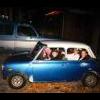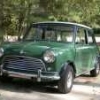Edited by WillMini, 22 May 2009 - 11:16 PM.

Clutch Arm Play
Started by
WillMini
, May 22 2009 11:12 PM
6 replies to this topic
#1

Posted 22 May 2009 - 11:12 PM
hi, i have a 1979 mini 1000 with a pre verto clutch. it does not shift very well (i have to double clutch to down shift and it doesn't really go into third without going to fouth first. i adjusted everything to Haynes clearances but it still doesn't shift well. I did however notice there was about 1/2 of an inch of play in the clutch lever arm, where i could move it half an inch or so before the throw out plunger would move. Could this be the cause of my poor shifting?
#2

Posted 22 May 2009 - 11:27 PM
Possibly, try winding out the return stop screw a bit more. The return stop should be set so there's a minimal gap between the release bearing and clutch plate' just enough to keep the bearing from spinning when the clutch is released. If you pull on the arm the resitance gets much stronger when the bearing contacts the plate
#3

Posted 23 May 2009 - 12:48 PM
i tried that, it get a bit better when i unscrew that bolt, but when its unscrewed enough to make the gear changes a bit better the clutch slips. is it possible that i put the clutch plate on backwards?? because i know the hydraulics are working because the piston almost comes out of the slave cylinder when i don't have the throw out plunger stop adjusted. I put a new clutch disk in but i did not replace the throw out bearing or the little plate it contacts, could this be the problem? Also when im stopped on a slight hill where most cars would roll back with the clutch in, mine does not, which makes me think the clutch is not disengaging properly. i dont know, im confused. I dont know what to replace or rip apart.
#4

Posted 23 May 2009 - 01:26 PM
You shouldn't be able to put the plate on arse about face and get it reassembled. if you've got clutch slip as a result of adjusting the return stop it's too far out.
The return stop (small bolt under the arm) regulates where the release mechanism starts pushing from. The throw out stop (big nuts in the centre of the clutch cover) limit how far the clutch pushes - if it is too far in it can stop the clutch disengaging. It's there to stop the clutch pushing the crank on to its thrust bearing, if it's too far out it won't effect the clutch operation.
Try winding the throwout stop out and pump the clutch pedal while trying that roll back test again (also try in neutral to be sure it is the clutch holding it). If you can get it to rollback it will be the hydraulics. Hydraulic faults coming to light after a new clutch aren't unusual. A new pressure plate can put a bigger load on them and a new friction plate can make the slave cylinder piston move over a different part of the cylinder.
The return stop (small bolt under the arm) regulates where the release mechanism starts pushing from. The throw out stop (big nuts in the centre of the clutch cover) limit how far the clutch pushes - if it is too far in it can stop the clutch disengaging. It's there to stop the clutch pushing the crank on to its thrust bearing, if it's too far out it won't effect the clutch operation.
Try winding the throwout stop out and pump the clutch pedal while trying that roll back test again (also try in neutral to be sure it is the clutch holding it). If you can get it to rollback it will be the hydraulics. Hydraulic faults coming to light after a new clutch aren't unusual. A new pressure plate can put a bigger load on them and a new friction plate can make the slave cylinder piston move over a different part of the cylinder.
#5

Posted 23 May 2009 - 01:32 PM
Ethel already suggested what I was going to recommend, setting the stop bolt gap to a minimum.
If you still see a lot of arm travel with a new clutch and shifting is difficult... you need to look at each component for wear and replace. When you add the wear up on each component, the total effect at the clutch can quickly become unacceptable. The wear occurs at these points:
1) ALL clevis pins; clutch master cylinder, throw out arm to pushrod, throw out arm to clutch cover.
2) Master cylinder clevis (the holes in the MC pushrod)
3) The slave pushrod
4) The throw out arm clevis holes (top for the slave, the bottom in the clutch cover)
5) The ball on the throw out arm
6) The hole inside the throw out rod with the release bearing on it.
When I've worked on these problems before, by far the worst wear was on the ball and hole in the throw out arm and throw out rod. The clevis (and pin) on the master cylinder were next. However, when you've taken the car apart far enough to replace these parts it is a waste of your time and effort if you don't replace the other parts at the same time.
If you still see a lot of arm travel with a new clutch and shifting is difficult... you need to look at each component for wear and replace. When you add the wear up on each component, the total effect at the clutch can quickly become unacceptable. The wear occurs at these points:
1) ALL clevis pins; clutch master cylinder, throw out arm to pushrod, throw out arm to clutch cover.
2) Master cylinder clevis (the holes in the MC pushrod)
3) The slave pushrod
4) The throw out arm clevis holes (top for the slave, the bottom in the clutch cover)
5) The ball on the throw out arm
6) The hole inside the throw out rod with the release bearing on it.
When I've worked on these problems before, by far the worst wear was on the ball and hole in the throw out arm and throw out rod. The clevis (and pin) on the master cylinder were next. However, when you've taken the car apart far enough to replace these parts it is a waste of your time and effort if you don't replace the other parts at the same time.
#6

Posted 23 May 2009 - 02:14 PM
okay, thanks for the replies, i took the throw out arm out and the ball is flat on one side. Which could be a culprit. the nearest mini specialist is about a 2 hour drive, so I'm going to weld some metal to the ball and file it round again. Sounds hokey, but I think it will work.
#7

Posted 24 May 2009 - 07:14 PM
I don't think that sounds hokey at all. (I did the same thing until I could get new parts!) You do what you have to do.
Remember, it's not going to have worn on just the ball. The place it contacts on the rod with the throw out bearing will also be worn away. Get both parts. Before you go, look at the clevis pins so you can pick them up if necessary.
Let us know how you make out.
Remember, it's not going to have worn on just the ball. The place it contacts on the rod with the throw out bearing will also be worn away. Get both parts. Before you go, look at the clevis pins so you can pick them up if necessary.
Let us know how you make out.
1 user(s) are reading this topic
0 members, 1 guests, 0 anonymous users














